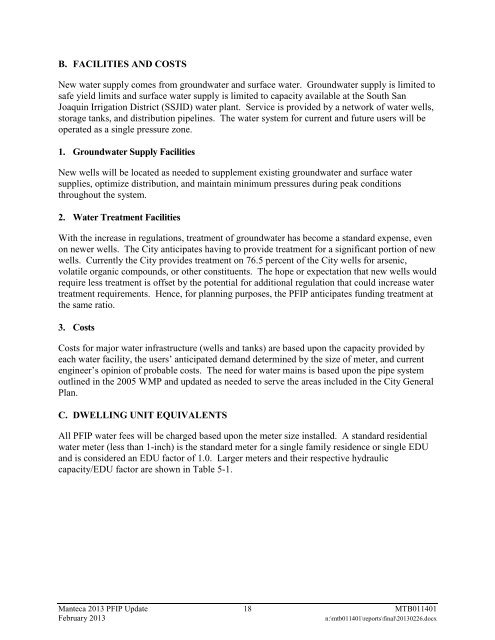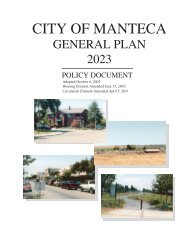2013 Public Facilities Implementation Plan Update - City of Manteca
2013 Public Facilities Implementation Plan Update - City of Manteca
2013 Public Facilities Implementation Plan Update - City of Manteca
You also want an ePaper? Increase the reach of your titles
YUMPU automatically turns print PDFs into web optimized ePapers that Google loves.
B. FACILITIES AND COSTS<br />
New water supply comes from groundwater and surface water. Groundwater supply is limited to<br />
safe yield limits and surface water supply is limited to capacity available at the South San<br />
Joaquin Irrigation District (SSJID) water plant. Service is provided by a network <strong>of</strong> water wells,<br />
storage tanks, and distribution pipelines. The water system for current and future users will be<br />
operated as a single pressure zone.<br />
1. Groundwater Supply <strong>Facilities</strong><br />
New wells will be located as needed to supplement existing groundwater and surface water<br />
supplies, optimize distribution, and maintain minimum pressures during peak conditions<br />
throughout the system.<br />
2. Water Treatment <strong>Facilities</strong><br />
With the increase in regulations, treatment <strong>of</strong> groundwater has become a standard expense, even<br />
on newer wells. The <strong>City</strong> anticipates having to provide treatment for a significant portion <strong>of</strong> new<br />
wells. Currently the <strong>City</strong> provides treatment on 76.5 percent <strong>of</strong> the <strong>City</strong> wells for arsenic,<br />
volatile organic compounds, or other constituents. The hope or expectation that new wells would<br />
require less treatment is <strong>of</strong>fset by the potential for additional regulation that could increase water<br />
treatment requirements. Hence, for planning purposes, the PFIP anticipates funding treatment at<br />
the same ratio.<br />
3. Costs<br />
Costs for major water infrastructure (wells and tanks) are based upon the capacity provided by<br />
each water facility, the users’ anticipated demand determined by the size <strong>of</strong> meter, and current<br />
engineer’s opinion <strong>of</strong> probable costs. The need for water mains is based upon the pipe system<br />
outlined in the 2005 WMP and updated as needed to serve the areas included in the <strong>City</strong> General<br />
<strong>Plan</strong>.<br />
C. DWELLING UNIT EQUIVALENTS<br />
All PFIP water fees will be charged based upon the meter size installed. A standard residential<br />
water meter (less than 1-inch) is the standard meter for a single family residence or single EDU<br />
and is considered an EDU factor <strong>of</strong> 1.0. Larger meters and their respective hydraulic<br />
capacity/EDU factor are shown in Table 5-1.<br />
<strong>Manteca</strong> <strong>2013</strong> PFIP <strong>Update</strong> 18 MTB011401<br />
February <strong>2013</strong> n:\mtb011401\reports\final\<strong>2013</strong>0226.docx
















